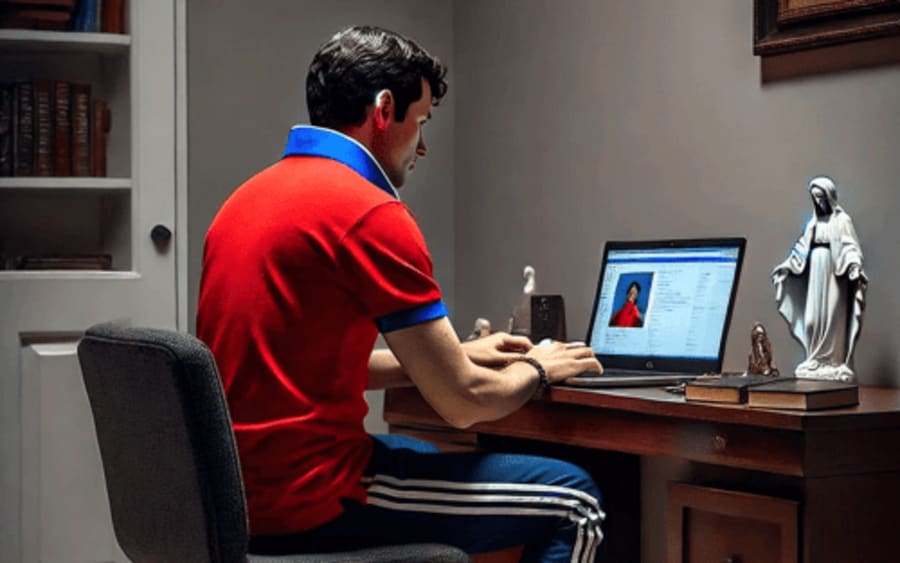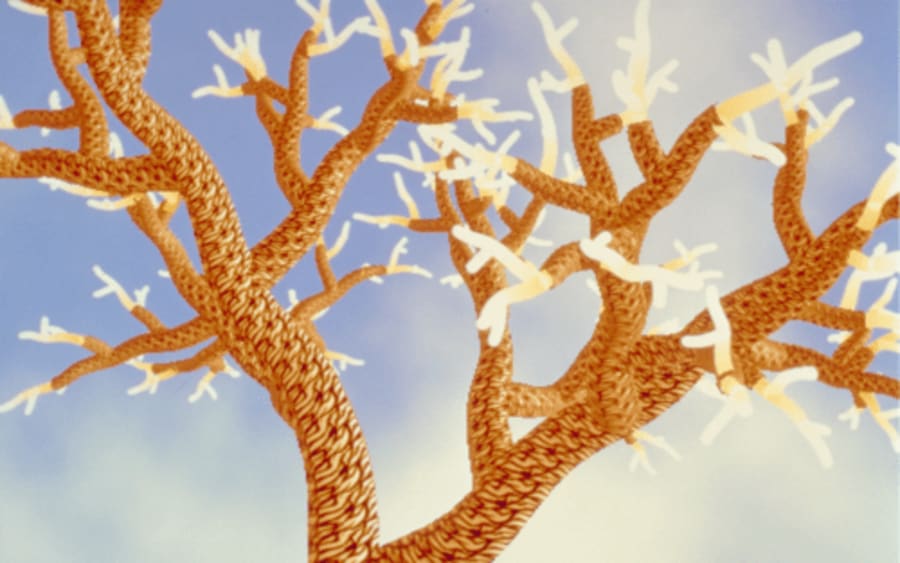Presenting dance in visual art spaces is nothing new. ‘Galleries have always provided a home for the more experimental end of choreography,’ says Catherine Wood, Director of Exhibitions and Programme at Tate Modern, London. She cites the late American postmodern dance pioneer Merce Cunningham and British ‘punk ballet’ choreographer Michael Clark as dancemakers from the late 20th century who were as at home in a gallery as on a stage, and who frequently collaborated with visual artists like Charles Atlas, Sarah Lucas, and Andy Warhol.
But there’s been a noticeable increase of choreography in galleries and museums in recent years. ‘A turn back towards choreography started happening in the 2000s with artists like Tino Sehgal,’ says Wood. ‘He came from dance but moved towards art and made interactive choreographies that involved speaking and movement with visitors.’ This year, dance seems to be everywhere in the artworld: think of American postmodern choreographer Yvonne Rainer’s seminal work Trio A
(1966) being performed at the Neue Nationalgalerie during this year’s Berlin Art Week, or renowned Paris-based choreographer Sharon Eyal’s performance inside a multimedia work by Es Devlin at Art Basel in Basel in June.
Why? Italian choreographer Michele Rizzo, best known for his nightclub-inspired work HIGHER (2015), suggests that an unstable political climate and the need for truth is prompting choreographers to opt for the more pragmatic environment of the gallery as opposed to theaters, where productions are grounded in creating illusions. Berlin-based choreographer Ligia Lewis, however, is critical of the ‘seduction of authenticity’ associated with dance in gallery spaces and still enjoys ‘artifice and illusion’ as a way of telling stories. She attributes the increase of dance in the artworld to globalization, which naturally promotes hybridity. Economic causes also can’t go unnoted. ‘Now we have much less funding for theater and dance,’ says Lewis, ‘so galleries and museums are starting to step in.’ London-based dancer and choreographer Sara Wookey also thinks wider sociocultural factors are at play. ‘In our mediated world, and [since] the pandemic, I think we are craving real, embodied experiences,’ she says.
Distinguishing dance from performance art is important when discussing its increased prevalence in galleries and museums. While the line between the two can get blurry, ‘in dance we think of the body as our instrument. We rest, warm up, and take baths,’ says Wookey. ‘In performance art, it can be the opposite, and be all about exhaustion and pushing physical limits.’ And dance is less accustomed to being shared on social media, as filming in theaters is usually prohibited. ‘My main issue [with this] is that it sucks attention away from the live performance and ends up devaluing it,’ says The Guardian dance critic Sanjoy Roy, who defines dance as putting ‘its primary focus on movement, whereas performance is more preoccupied with live presence.’ As a result, dance audiences may find the new forms dance takes in a gallery setting unfamiliar. ‘I’m quite invested in work having a beginning and an end, so pieces that are “durational” or “a performance object” start making me anxious,’ says Roy. ‘When does it start? Has it finished yet? Should I stay longer in case I miss something? Is it rude to leave this early?’
Still, the openness Roy describes can be exactly what attracts choreographers to art spaces. ‘Artists often … really like being able to draw a crowd of passersby, and the informality of that,’ says Wood. ‘It’s very much about calibrating attention and holding it.’ Other attractions range from a closer connection with the audience – for Rizzo, galleries are ‘more personal and intimate’ than theaters – to the ability to create work in dialogue with museum collections. For example, 2021 Prix de Rome winner Alexis Blake’s Allegory of the Painted Woman (2012–ongoing), which has been performed at Amsterdam’s Rijksmuseum, among other venues, questions ‘the Western art-historical canon and museum collections from a feminist perspective.’
Exploring ideas in art spaces can also provide choreographers with new learnings to take back to their stage works. For Lewis, for example, experimenting with lighting in her institutional shows has encouraged her to analyze how it could be an extension of the body, rather than an unquestioned element of production as it can be in theater. The ability for audiences to observe the intricate details of choreography is another draw to the gallery space, according to British choreographer Siobhan Davies, who started making work for museums in 2000. These specificities, she told me when I interviewed her for my podcast, Terpischore, often get lost in the vastness of traditional theaters.
Choreographic details are not the only things that can get lost in the theater: contemporary/modern dance history can dissolve into obscurity due to its innate ephemerality and the industry’s preference for creating new live work over preserving the old. As such, the fact that art museums – houses of preservation by nature – have an increasing interest in dance is a great help in the quest to capture, document, and share lesser-known performance histories. The current Edges of Ailey exhibition at the Whitney Museum of American Art in New York, which celebrates the legacy of pre-eminent African-American dancer, choreographer, and civil-rights activist Alvin Ailey, is a prime example. It’s an ‘important political move’ according to Lewis, since postmodern dance figures, such as the Judson Dance Theater collective, who enjoyed a retrospective at New York’s Museum of Modern Art (MoMA) back in 2018, have been the artworld’s key reference point for dance for too long. ‘Historically, Black dancers have been written out of that trajectory, so it’s super important to have someone as iconic and influential as Ailey [celebrated in an art context],’ she says. ‘Finally we can break with a really reductive idea of what dance is.’
While not as easy as acquiring inanimate art objects, museums have become more skilled at collecting and conserving dance over the years. ‘A flat [video] documentation of a great dance piece doesn’t cut it,’ says Wood. Instead, methods such as showcasing products of collaboration between dancers and artists from other disciplines or certifying dancers to serve as living archives of specific works are becoming more common. Carmela Hermann Dietrich and Sarah Swenson, for example, are instructors of Italian-American choreographer Simone Forti’s seminal Dance Constructions (1960–1), which were acquired by MoMA in 2015. Likewise, Wookey is a teacher of Rainer’s Trio A, and was responsible for staging the aforementioned performance of the work in Berlin. Alongside colleagues, she’s currently investigating how the unique verbal lexica choreographers use may be helpful in the conservation process. ‘There’s this old idea that dancers use their body but not their voice, but [they] are incredibly articulate. I have hundreds of note cards capturing [Rainer’s] language,’ she says, explaining that the words she used to talk about dance would be wildly different to someone like Martha Graham. ‘Words [in choreography] are fascinating and open up worlds.’
Despite the growing recognition of ephemeral art forms – UNESCO established its intangible cultural heritage program in 2009 to protect traditions, rituals, social practices, and performing arts, with German modern dance receiving UNESCO status in 2022 – economic structures within the artworld pose challenges for live dance exhibitions. Wood explains that ‘at a museum like Tate, the economy is based around five-month exhibitions,’ which tend to attract more visitors than a performance that occurs two or three times. ‘I’d love to disrupt that and hijack the painting galleries for live dance in a more ambitious way,’ she adds.
Interestingly, new moves incorporating art and dance in different ways, and including novel technological structures, are also paving the way for new models of collaboration and support. In October, Paris Opera launched Coddess Variations, a collection of sculptural artworks, a film by Hervé Martin Delpierre, and a live dance performance that takes place in the Grand Foyer of the Palais Garnier. The latter is based on algorithmically generated choreographies by Ania Catherine, part of the American digital-artist duo Operator, and the collection will be for sale on the blockchain. Will the artworld’s fascination with dance endure long enough to inspire genuine investment in this medium? Only time will tell.
Emily May is a British-born, Berlin-based writer specializing in dance and performance.
Artist, choreographer, and director Ligia Lewis spoke on interdisciplinarity in the museum in the Conversations program at Art Basel in Basel in June 2024. Watch here.
Cover image: 10,000 Gestures by Boris Charmatz, at Tate Modern, 2019. Photo © Tate (Alex Wojcik).
Published on October 21, 2024.


